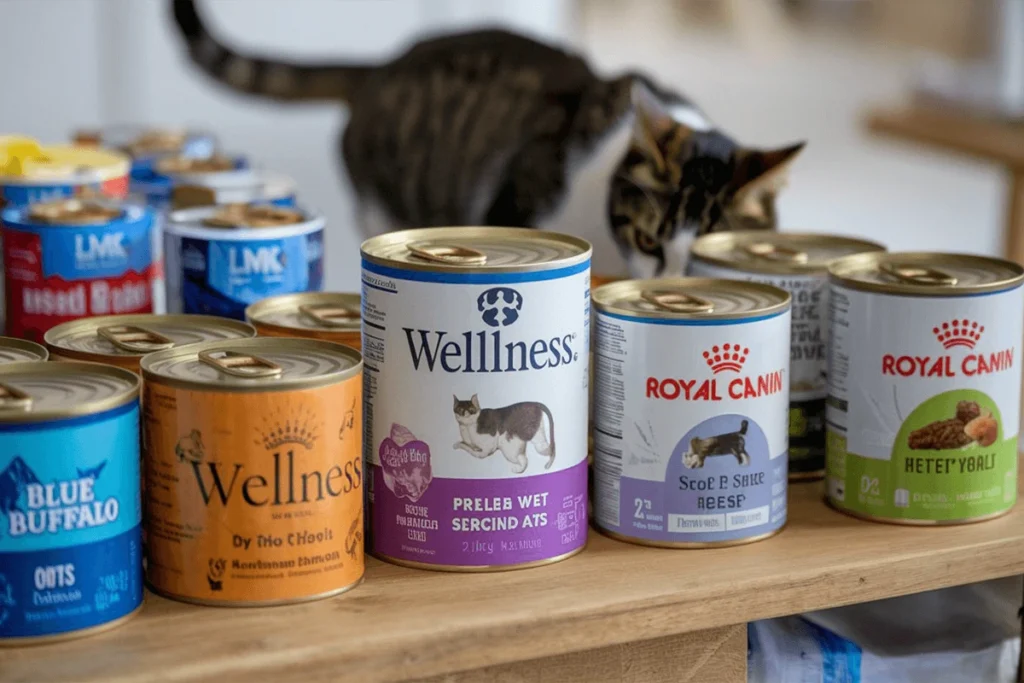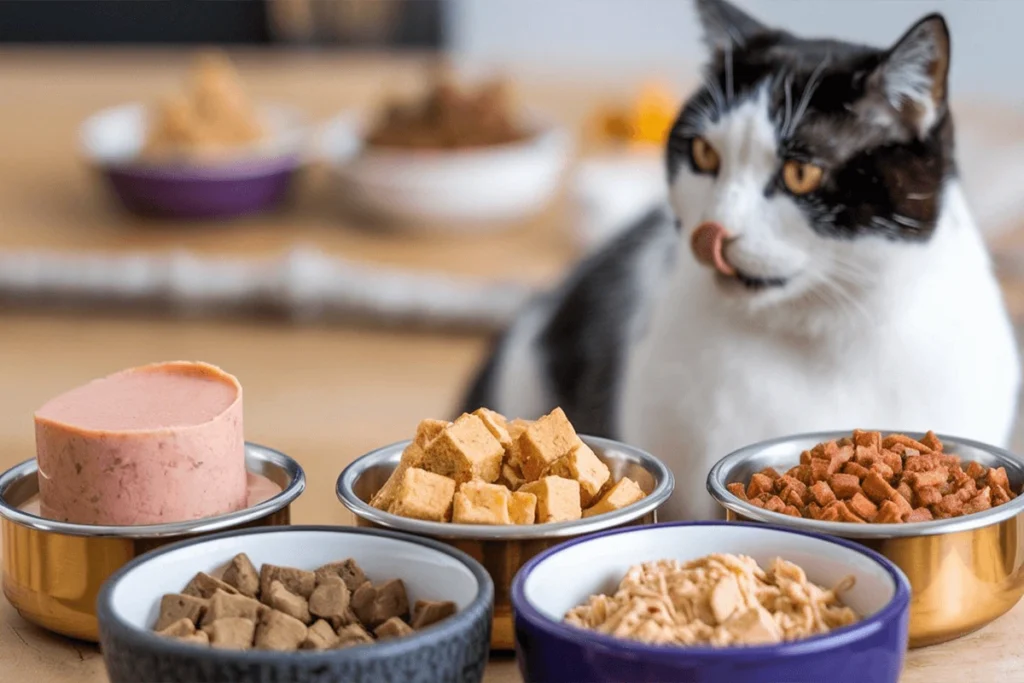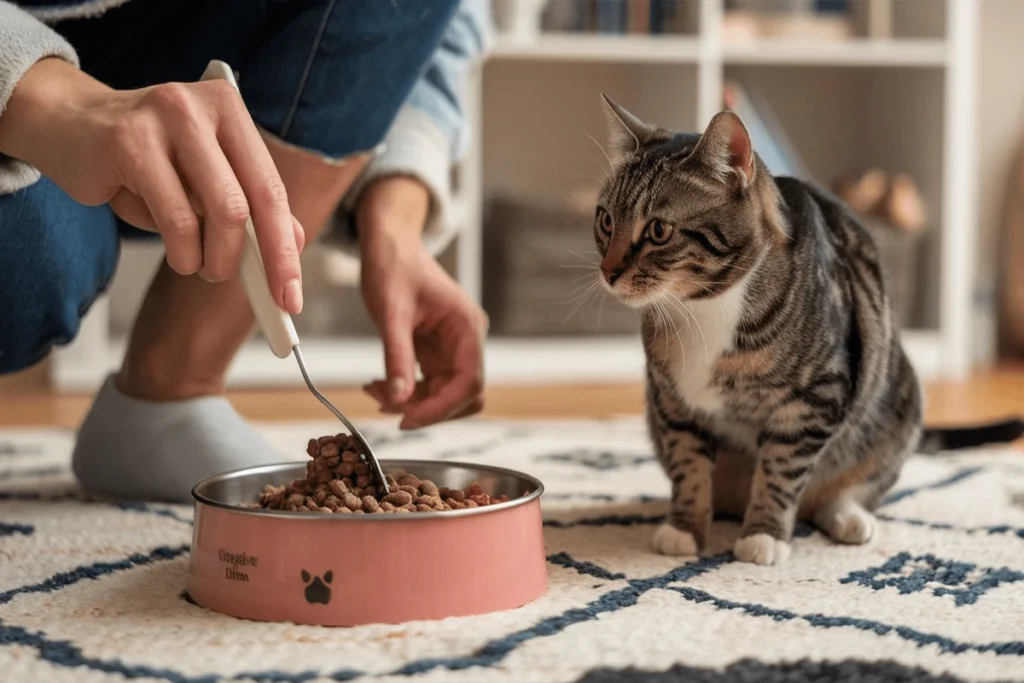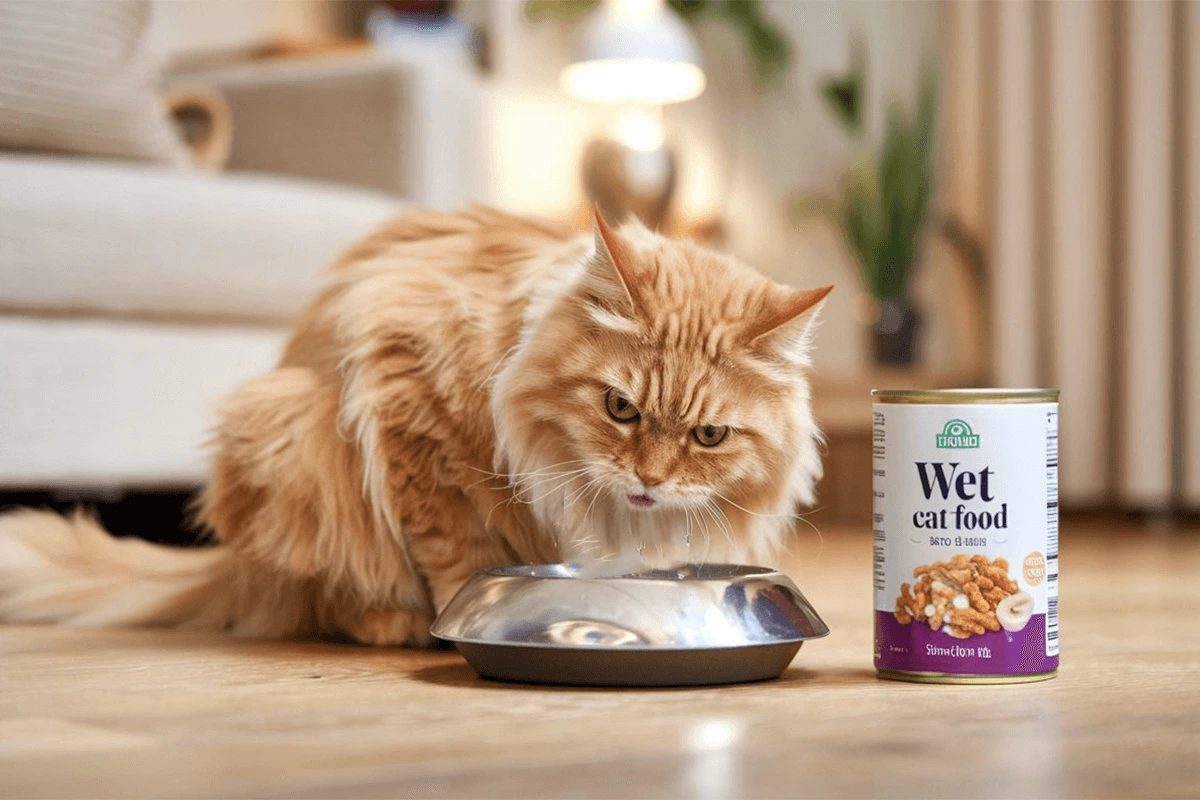Choosing the best wet cat food plays a crucial role in keeping your feline friend happy and healthy. Unlike dry kibble, wet food provides essential hydration, making it an excellent choice for cats who don’t drink enough water. It also offers a rich, meaty texture that mimics a cat’s natural diet, making it more appealing to picky eaters.
Beyond hydration and taste, wet cat food delivers high-quality protein, essential nutrients like taurine, and healthy fats such as Omega-3 and Omega-6. These nutrients support muscle growth, a shiny coat, and overall well-being. Many formulas meet AAFCO standards, ensuring they provide complete and balanced nutrition for cats of all ages.
With so many brands and formulas available, choosing the right one can feel overwhelming. Some cats prefer pâté, while others enjoy chunks in gravy. Certain options cater to specific needs, such as grain-free wet cat food, high-protein diets, or soft cat food for seniors. This guide will help you understand what to look for, explore top-rated brands like Blue Buffalo, Wellness, and Royal Canin, and provide tips to transition your cat to a healthier diet.
By the end of this guide, you’ll have the knowledge to choose the best wet cat food tailored to your cat’s nutritional needs and preferences.
Why Choose Wet Cat Food Over Dry Food?
Better Hydration: Why Moisture Matters for Your Cat
Cats naturally have a low thirst drive because their ancestors were desert-dwelling hunters who relied on moisture-rich prey for hydration. Unlike dogs, which instinctively drink water throughout the day, cats often fail to drink enough from their water bowls. This can lead to dehydration, which may cause kidney problems, constipation, and urinary tract infections.
Wet cat food contains about 70-80% moisture, making it an excellent way to increase your cat’s daily water intake. Proper hydration supports kidney function, digestion, and urinary health, reducing the risk of issues like urinary crystals and bladder stones. Cats prone to urinary problems, such as male cats and senior cats, particularly benefit from a moisture-rich diet.
In addition to feeding wet cat food, encourage hydration by placing multiple water bowls around your home or using a cat water fountain, which mimics the movement of natural running water. However, if your cat refuses to drink enough water, a wet food diet can be a simple yet effective solution to maintaining optimal hydration levels.
Nutritional Benefits: Essential Nutrients for a Healthy Cat
Feeding wet cat food ensures your feline gets the nutrients necessary for a long, healthy life. A high-protein diet supports lean muscle mass, energy levels, and overall strength, making protein one of the most critical components of any cat food. Look for formulas with real animal proteins like chicken, turkey, beef, or fish as the first ingredient.
Cats also require taurine, an essential amino acid that supports heart health, vision, and proper digestion. Unlike humans or dogs, cats cannot produce enough taurine on their own, so they must get it from their diet. Many AAFCO-approved wet cat foods contain adequate levels of taurine to meet feline dietary needs.
Another key nutritional benefit of wet food is its healthy fat content, particularly Omega-3 and Omega-6 fatty acids. These fats contribute to a shiny coat, healthy skin, and reduced inflammation, especially for cats with allergies or joint issues. Some premium brands even include added vitamins, minerals, and probiotics to support immune function and digestion.
For cats with food sensitivities or allergies, grain-free wet cat food can be a great option. Grain-free formulas eliminate common allergens like corn, wheat, and soy, replacing them with digestible carbohydrates like sweet potatoes or peas. This can help prevent digestive upset and promote better nutrient absorption.
Texture and Palatability: Finding the Right Fit for Your Cat
Cats are known for being selective eaters, and the texture of their food plays a major role in what they enjoy. Unlike dry kibble, which is hard and crunchy, wet cat food comes in a variety of textures, allowing cat owners to cater to their pet’s preferences.
- Pâté: A smooth, soft texture that is easy to chew and digest. Ideal for kittens, senior cats, and cats with dental issues.
- Shredded & Flaked: Thin strands of meat in broth or gravy, offering a more natural, meat-like texture. Great for cats who enjoy chewing.
- Chunks in Gravy: Small, soft meat chunks in a flavorful sauce. Perfect for cats who like a mix of texture and moisture.
- Minced or Morsels: Tiny meat pieces in light gravy or broth, providing variety for picky eaters.
If your cat turns its nose up at a new wet food, experiment with different textures to find the one they prefer. Some cats enjoy lapping up gravy-based food, while others like chewing on meaty chunks. A cat’s preference may also change over time, so offering a variety can keep mealtime interesting.
Additionally, wet food’s soft texture makes it an excellent choice for older cats with missing teeth, dental issues, or reduced jaw strength. If your senior cat struggles with kibble, switching to a softer food can make eating easier and more enjoyable.
By understanding your cat’s individual needs and preferences, you can select the best wet food that satisfies both their nutritional requirements and taste preferences, ensuring a healthy and happy feline!
Key Nutritional Factors in Wet Cat Food
High-Protein Content: Essential for a Strong and Healthy Cat
Cats need to eat meat to stay healthy. They are called obligate carnivores because they require a lot of animal protein in their food to live well. Unlike humans or dogs, cats depend on protein as their primary energy source. Wet cat food with high-quality protein supports muscle development, healthy organ function, and overall vitality. It also provides essential amino acids, such as taurine, which is crucial for heart health, vision, and digestion.

When choosing wet food, check the ingredient list to ensure real meat, poultry, or fish is listed as the first ingredient. Look for proteins like chicken, turkey, beef, salmon, or tuna, as these provide the best nutritional value. Avoid products that rely heavily on plant-based proteins like peas or soy, as cats digest animal proteins more efficiently.
High-protein wet food is especially important for active cats, growing kittens, and senior cats who need extra muscle support. Protein also helps maintain a healthy weight, as it keeps cats full longer and prevents excessive snacking. If your cat struggles with maintaining muscle mass or energy levels, switching to a high-protein wet food can significantly improve their overall health.
Grain-Free vs. Regular Options: Which One is Right for Your Cat?
Grain-free wet cat food has become a popular choice, but is it the best option for every cat? Traditional wet food often contains grains like rice, corn, or wheat, which serve as carbohydrate sources. While some cats tolerate grains well, others may experience digestive issues, food sensitivities, or allergies.
Grain-free wet cat food eliminates grains and instead uses alternative carbohydrate sources like sweet potatoes, lentils, or peas. These formulas can be beneficial for cats with sensitive stomachs or skin allergies. Some pet owners also prefer grain-free options because they more closely mimic a cat’s natural diet, which is primarily composed of meat, moisture, and minimal carbohydrates.
However, not all grain-free diets are superior. Some brands replace grains with excessive plant-based fillers, reducing the overall protein content. If you choose a grain-free formula, ensure it still contains high-quality animal protein as the main ingredient and not just a high amount of peas or potatoes.
For cats with no known allergies, a well-balanced regular wet cat food with grains can still provide excellent nutrition. The key is to focus on protein quality, essential nutrients, and overall ingredient transparency rather than just whether the food contains grains.
AAFCO Standards: Ensuring Complete and Balanced Nutrition
When selecting wet cat food, it’s important to check if the product meets AAFCO (Association of American Feed Control Officials) standards. AAFCO establishes nutritional guidelines that ensure pet food contains the necessary nutrients for a cat’s life stage, whether they are a kitten, adult, or senior.
Look for packaging that states the food is “complete and balanced” according to AAFCO guidelines. This means the wet food provides all the essential nutrients your cat needs without requiring additional supplements. Foods that don’t meet these standards may lack key vitamins and minerals, leading to potential health deficiencies.
AAFCO guidelines also help differentiate between supplemental or treat-based wet food and nutritionally complete meals. Some wet foods are formulated as toppers or treats, meant to be mixed with other food rather than fed alone. Ensuring that your cat’s primary diet meets AAFCO standards guarantees they receive the right balance of protein, fats, vitamins, and minerals for optimal health.
By choosing high-protein, nutritionally balanced wet cat food—whether grain-free or not—you can provide your cat with the essential nutrients they need to stay healthy, active, and happy.
Best Wet Cat Food Brands to Consider
Premium Options: High-Quality Ingredients for Optimal Health
Premium wet cat food brands focus on using high-quality, natural ingredients without artificial additives, fillers, or by-products. These options often contain real meat, poultry, or fish as the first ingredient, providing an excellent source of protein for your cat’s muscle development and overall health. Many premium brands also include beneficial nutrients like Omega-3 and Omega-6 fatty acids to promote a shiny coat, healthy skin, and reduced inflammation.
Additionally, premium wet cat food tends to have better ingredient transparency, ensuring that what you feed your cat is free from unnecessary fillers such as corn, wheat, soy, and artificial preservatives. These foods may also use human-grade or responsibly sourced meat, making them a great choice for pet owners who prioritize quality.

Some of the most popular premium wet cat food brands include:
- Blue Buffalo – Uses high-protein ingredients with no artificial preservatives.
- Wellness – Offers grain-free and limited-ingredient options for cats with sensitivities.
- Royal Canin – Provides tailored nutrition for different breeds and life stages.
While premium options can be more expensive, they often provide better digestibility, superior nutrition, and improved palatability, making them ideal for cats with specific dietary needs or picky eating habits.
Vet-Recommended Choices: Expert-Approved for Special Diets
If your cat has specific health conditions, such as kidney disease, obesity, diabetes, or food allergies, your veterinarian may recommend a specialized wet food diet. Vet-recommended wet cat food is formulated to target specific health concerns while still providing complete and balanced nutrition.
For example, cats with kidney disease benefit from wet foods with lower phosphorus and controlled protein levels, such as those offered by Hill’s Science Diet or Royal Canin Veterinary Diet. Diabetic cats require high-protein, low-carbohydrate wet food to help regulate blood sugar levels, making Purina Pro Plan Veterinary Diets a common choice.
Vet-recommended brands are typically backed by scientific research and formulated to meet AAFCO standards, ensuring they provide the right balance of nutrients. Some trusted vet-recommended brands include:
- Hill’s Science Diet – Known for its prescription diets for various health issues.
- Royal Canin Veterinary Diet – Offers breed-specific and medical-condition formulas.
- Purina Pro Plan Veterinary Diets – Specializes in gastrointestinal and metabolic health formulas.
If your cat requires a specialized diet, consult your veterinarian to determine the best wet cat food to support their health needs.
Budget-Friendly Picks: Affordable Nutrition Without Compromise
Not all high-quality wet cat food needs to be expensive. Many budget-friendly brands provide nutritionally balanced, protein-rich meals without breaking the bank. The key is to find options that contain real meat as the first ingredient, avoid artificial preservatives, and still meet AAFCO standards for complete nutrition.
While budget brands may use more fillers or by-products than premium options, some still offer excellent nutrition at a lower price. Look for brands that balance affordability with quality ingredients, such as:
- Purina Fancy Feast – Widely available and offers a variety of textures and flavors.
- Friskies – A cost-effective option with high moisture content for hydration.
- Sheba – Affordable and made with real meat, often available in portioned servings.
If you’re on a budget but want to provide nutritious wet food, consider buying in bulk, looking for sales or subscription discounts, and mixing wet food with some dry kibble to stretch your budget while keeping your cat healthy and satisfied.
By understanding the differences between premium, vet-recommended, and budget-friendly wet cat food options, you can choose the best food that meets both your cat’s needs and your budget while ensuring they receive proper nutrition.
Choosing the Right Wet Cat Food for Your Feline
Age-Specific Needs: Choosing the Right Wet Food for Every Life Stage
Cats have different nutritional requirements depending on their age, and feeding them the right wet cat food ensures they stay healthy at every stage of life.
Kittens (Under 1 Year)
Kittens need high-protein, high-calorie wet food to support their rapid growth and energy levels. They also require essential nutrients like taurine, DHA, and Omega-3 fatty acids for brain development, vision, and a strong immune system. Look for formulas labeled “Kitten” or “Growth & Development”, as these are specifically designed to meet their needs. Many brands offer soft pâté textures that are easier for tiny teeth to chew and digest.
Adult Cats (1-7 Years)
Once cats reach adulthood, they require a well-balanced diet with moderate protein, fats, and hydration. Wet food options for adult cats should support muscle maintenance, energy levels, and digestive health. Depending on your cat’s lifestyle, you may need to choose a formula tailored to weight control, hairball prevention, or food sensitivities.
Senior Cats (7+ Years)
Senior cats often experience slower metabolism, reduced appetite, and dental issues, making soft, high-moisture wet food a great choice. Look for wet cat food that contains joint-supporting ingredients like glucosamine and chondroitin, as well as easy-to-digest proteins. Many senior-specific formulas also focus on kidney health and heart function by controlling phosphorus and sodium levels.
Choosing age-appropriate wet food helps support your cat’s energy, health, and overall well-being throughout their life.
Flavor & Texture Preferences: Catering to Your Cat’s Taste
Cats can be picky eaters, and their food preferences often depend on both flavor and texture. Understanding what your cat enjoys can help make mealtime more enjoyable and reduce food waste.

Flavor Preferences
Cats have a strong sense of smell, so they are naturally drawn to rich, meaty flavors. Some common wet food flavors include:
- Chicken & Turkey – Light, lean proteins that most cats enjoy.
- Beef & Lamb – More robust and hearty flavors, ideal for meat-loving cats.
- Salmon, Tuna & Whitefish – Strong-smelling fish flavors that attract seafood lovers.
If your cat refuses a certain flavor, try switching to another protein source. Some cats prefer poultry-based foods, while others enjoy fish-based meals.
Texture Preferences
The texture of wet cat food plays a major role in whether your cat will eat it. Wet food comes in various textures, such as:
- Pâté – Smooth and soft, ideal for kittens, seniors, and cats with dental issues.
- Shredded & Flaked – Thin strands of meat in broth, offering a more natural chewing experience.
- Chunks in Gravy – Bite-sized meat pieces in flavorful sauce, great for cats who love extra moisture.
- Minced & Morsels – Small, soft meat pieces, perfect for picky eaters who enjoy varied textures.
If your cat is hesitant to try a new food, experiment with different textures and flavors to see what they prefer. Mixing textures, such as combining pâté with shredded food, can also make meals more appealing.
Packaging Considerations: Convenience, Freshness & Sustainability
The packaging of wet cat food affects convenience, portion control, freshness, and environmental impact. Choosing the right packaging can make feeding your cat easier while reducing waste.
Cans
- Best for bulk buying and long shelf life.
- Available in different sizes (3 oz., 5.5 oz., 12 oz.) for various portion needs.
- Look for BPA-free cans to avoid potential chemical exposure.
- Must be refrigerated after opening.
Pouches
- Convenient for single-serving portions, reducing waste.
- Easy to store and serve, with no need for refrigeration before opening.
- Some brands offer recyclable packaging, making them an eco-friendly choice.
Plastic Trays & Cups
- Similar to pouches but often include peel-off lids.
- Great for portion control, as they typically contain a single meal.
- Some trays come with resealable lids for easy storage.
Sustainability & Environmental Impact
If you’re concerned about the environment, look for brands that offer recyclable or eco-friendly packaging. Some brands use biodegradable trays, recyclable cans, or sustainable sourcing methods to reduce waste.
Choosing the right wet cat food packaging ensures that meals stay fresh, feeding is convenient, and environmental impact is minimized.
By considering age-specific needs, flavor and texture preferences, and packaging options, you can find the perfect wet food that keeps your cat happy, healthy, and well-fed.
Tips for Transitioning Your Cat to Wet Food
Gradual Introduction: Transitioning Your Cat to Wet Food Smoothly
Switching your cat to a new wet cat food should be done gradually to avoid digestive upset and rejection. Cats can be creatures of habit, and sudden dietary changes may lead to stomach issues or refusal to eat.
Step-by-Step Transition Plan:
- Days 1-2: Mix 75% of the old food with 25% of the new wet food.
- Days 3-4: Adjust to a 50/50 mix of the old and new food.
- Days 5-6: Increase the new food to 75%, while reducing the old food to 25%.
- Day 7: Fully transition to 100% wet food.
During this process, observe your cat’s behavior and digestion. Some cats adjust quickly, while others need a longer transition period. If your cat refuses to eat, try warming the wet food slightly to enhance the aroma or mixing it with a bit of their old food for familiarity.

For cats who are used to dry kibble, adding a little water or broth to the wet food can help ease the transition by making the texture more appealing. The key is to be patient and consistent, ensuring your cat gradually accepts and enjoys their new diet.
Monitoring Your Cat’s Response: Ensuring a Smooth Adjustment
Once you’ve introduced wet cat food into your cat’s diet, it’s important to monitor their health, behavior, and digestion to ensure the new food agrees with them.
Signs of a Positive Response:
- Increased appetite and enthusiasm at mealtime.
- Healthy weight maintenance or gradual improvement.
- Shiny coat and healthy skin (thanks to Omega-3 and Omega-6 fatty acids).
- Consistent energy levels and playful behavior.
- Well-formed, regular stools (not too hard or too soft).
Signs That May Require Adjustment:
- Vomiting, diarrhea, or constipation (indicating possible food intolerance).
- Loss of appetite or refusal to eat (may need a different flavor or texture).
- Weight loss or excessive weight gain (adjust portion sizes accordingly).
If your cat experiences digestive issues or allergic reactions, try switching to a different protein source or grain-free option. Some cats have sensitivities to ingredients like chicken, beef, or dairy, so finding the right formula is key. If problems persist, consult your veterinarian for guidance on selecting the best diet for your cat’s needs.
Storage & Serving Tips: Keeping Wet Cat Food Fresh and Safe
Proper storage and serving of wet cat food ensures your cat gets fresh, safe, and nutritious meals every time.
Storage Tips:
- Unopened wet cat food should be stored in a cool, dry place, away from direct sunlight.
- Once opened, refrigerate leftovers in an airtight container or cover the can with a lid to prevent drying out.
- Use refrigerated wet food within 2-3 days to maintain freshness and prevent spoilage.
Serving Tips:
- Always serve wet food at room temperature. Cats prefer their food warm, as it enhances the aroma and makes it more appetizing.
- If refrigerated, let the food sit at room temperature for 15-20 minutes before serving or warm it slightly in the microwave for 5-10 seconds (avoid overheating).
- Use clean bowls made of stainless steel or ceramic to prevent bacteria buildup. Plastic bowls can trap odors and bacteria, which may cause food rejection.
By following proper storage and serving practices, you can keep your cat’s wet food fresh, appealing, and safe, ensuring they enjoy every meal while getting the nutrition they need.
A gradual introduction, close monitoring, and proper food handling will help make the transition to wet cat food smooth and beneficial for your cat’s overall health.
Conclusion
Finding the best wet cat food for your cat involves more than just picking a brand off the shelf. You need to consider their age, dietary needs, texture and flavor preferences, and overall health requirements to ensure they receive the proper nutrition. High-quality wet food provides essential hydration, protein, vitamins, and minerals that support muscle development, digestion, coat health, and energy levels.
If your cat has specific dietary needs, whether it’s grain-free options, high-protein formulas, or vet-recommended special diets, take the time to read ingredient labels and choose foods that meet AAFCO nutritional standards. Some cats thrive on premium wet cat food with responsibly sourced ingredients, while others do well with budget-friendly yet balanced options.
Introducing wet food into your cat’s diet should be a gradual process, ensuring they adapt comfortably while avoiding digestive issues. Monitoring their health, appetite, and digestion allows you to make necessary adjustments, whether that means switching textures, adjusting portion sizes, or selecting a different protein source.
Proper storage and serving practices also play a crucial role in keeping wet food fresh and appealing. Always store opened cans properly, serve food at the right temperature, and use clean feeding bowls to maintain hygiene.
By choosing the right wet cat food and following the best feeding practices, you can give your cat a nutritious, delicious, and satisfying diet that supports their overall well-being, longevity, and happiness. A well-fed cat is a happy cat, and a happy cat makes for a content and loving pet owner.
Discover the Top Homemade Cat Food & the best Recipes For a Healthy & Happy Feline!
What’s the best Cat Food Every Owner Should Know About?
Learn the Top Dry Cat Food For a Healthy & Happy Feline.
Get The Best Stuff for your Cat From Pet MD Official
